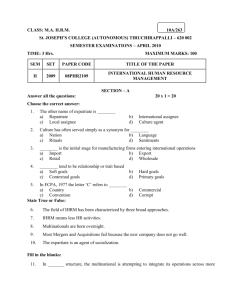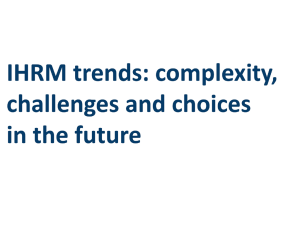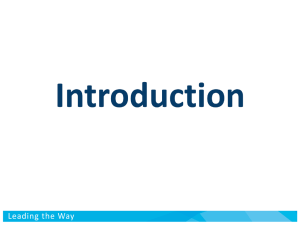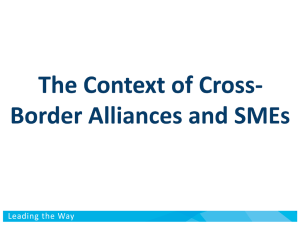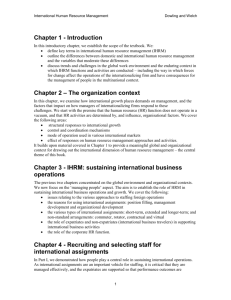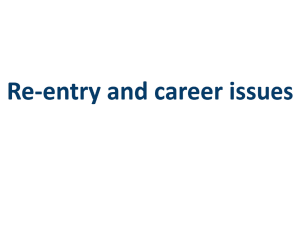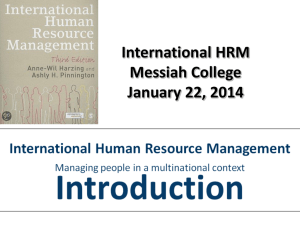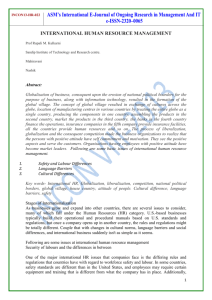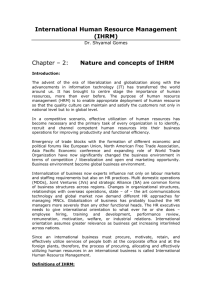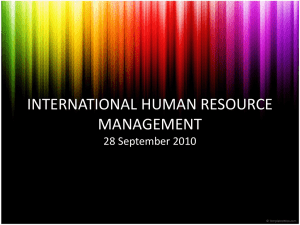HUMAN RESOURCE MANAGEMENT IN MULTINATIONAL RETAIL
advertisement
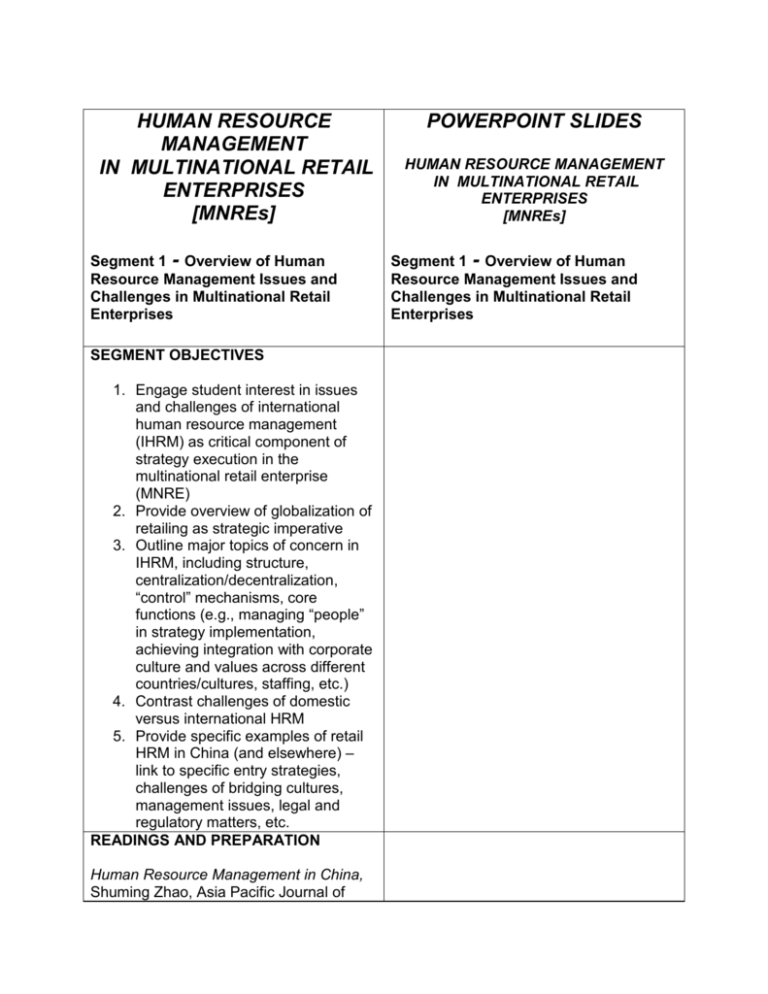
HUMAN RESOURCE MANAGEMENT IN MULTINATIONAL RETAIL ENTERPRISES [MNREs] Segment 1 - Overview of Human Resource Management Issues and Challenges in Multinational Retail Enterprises SEGMENT OBJECTIVES 1. Engage student interest in issues and challenges of international human resource management (IHRM) as critical component of strategy execution in the multinational retail enterprise (MNRE) 2. Provide overview of globalization of retailing as strategic imperative 3. Outline major topics of concern in IHRM, including structure, centralization/decentralization, “control” mechanisms, core functions (e.g., managing “people” in strategy implementation, achieving integration with corporate culture and values across different countries/cultures, staffing, etc.) 4. Contrast challenges of domestic versus international HRM 5. Provide specific examples of retail HRM in China (and elsewhere) – link to specific entry strategies, challenges of bridging cultures, management issues, legal and regulatory matters, etc. READINGS AND PREPARATION Human Resource Management in China, Shuming Zhao, Asia Pacific Journal of POWERPOINT SLIDES HUMAN RESOURCE MANAGEMENT IN MULTINATIONAL RETAIL ENTERPRISES [MNREs] Segment 1 - Overview of Human Resource Management Issues and Challenges in Multinational Retail Enterprises Human Resources, Vol. 32, No. 2, 3-12 (1994) PERIPHERALS • • • A brief “quiz” dealing with business protocol and “manners” across a variety of countries and cultures, including China, to engage initial student interest Video segments of retail executives discussing their international expansion plans and experiences, including some with specific reference to IHRM PowerPoint slides supporting presentation INTRODUCTION TO INTERNATIONAL HUMAN RESOURCE MANAGEMENT Differences in culture and behavior 1. Distribute “quiz” about differences in • Communications business protocol and interpersonal • Status differences behavior across a number of countries • Gender roles and culture. (Quiz attached as • Stereotypes supplemental document.) • Rewards and recognition 2. Have students complete quiz items, then lead discussion on their responses, and whether there were any surprises. 3. Discuss the implications of these differences for the practice of international human resource management. Consider such topics as communications, status differences, gender roles, stereotypes, how people are recognized and rewarded, etc. 4. Indicate that in this and subsequent segments of this module, you will consider a number of factors which impact the practice of international human resource management (IHRM) decisions, policies and practices – including “culture” (which will be covered more thoroughly in Segment 3). 5. Topics will include overall IHRM strategy, ways to design and structure the IHRM practice, how IHRM practices typically evolve over time, and a closer look at specific HR practices areas, such as selection, training, performance management, recognition and rewards, and legal/ethical issues. THE CHANGING FACE OF BUSINESS IN “Global” whether you choose AN INTEGRATED WORLD to be or not! 1. Virtually every company now finds itself competing in a “global” environment, even if it doesn’t offer services or sell products outside its home country boundaries. 2. Sourcing, manufacturing and other functions are increasingly global in • • • • • Sourcing Manufacturing Low-cost suppliers Global competitors Integrated monetary systems nature. Finding low-cost vendors and developing/maintaining productive relationships with them requires knowledge and skills at dealing with people around the world. 3. Competition from global players – including international joint ventures, subsidiaries with foreign ownership, partnerships and alliances essentially guarantees that every organization will find itself in the midst of a globally competitive environment. 4. Retail is no exception. Indeed, retailers have been among the first movers in multinational expansion. For example, KFC’s Colonel Sanders and striped red buckets, McDonald’s golden arches and Pizza Hut’s red roof logo have become familiar sights in countries around the globe. Luxury brands such as Louis Vuitton, Coach and Hermes have exclusive shops in many major cities, and hypermarkets and mass merchandisers such as Carrefour, Tesco and Walmart (plus the many subsidiaries they operate under various names) have a reach that spans the continents. The international expansion continues in multiple directions, including into highly developed markets such as the U.S., with companies like 7-11 (Japaneseowned) a common sight. (Insert pictures of restaurants, logos) FACTORS CREATING GLOBALIZATION PRESSURES There is no single source for the development of such an explosion of international expansion. Rather, a number of factors coincide to create the climate for global growth: 1. Increased international travel -creates wider exposure, changing expectations, demands for new and innovative products and services 2. Rapid and extensive global communication – both traditional media, and especially the internet 3. Rapid development and diffusion of new technology – makes every country a potential “player” in the global market 4. Free trade – spurred by the World Trade Organization and other trade organizations – increasingly opens markets 5. Education – making it possible to produce goods worldwide, often using local talent 6. Mass migrations of millions of people 7. Knowledge sharing – leading to the export not only of products and service, but also management approaches, business designs and processes 8. Cost pressures – often requiring outsourcing, offshore suppliers, etc. 9. Search for new markets, especially by companies based in countries with mature markets, and thus little opportunity to grow within national boundaries 10. Homogenization of cultures, thanks in large part to global communication, the internet, movies, etc. 11. E-commerce – permitting even small firms to conduct business via the internet (Source: International Human Resource Factors in globalization • • • • • • • • • • • Increased travel Global communications New technology Free trade Education Mass migrations Knowledge sharing Cost pressures Search for new markets Homogenization of cultures E-commerce Management, (3rd ed.), 2009, pp. 11-13, Dennis R. Briscoe, Randall S. Schuler, Lisbeth Claus, Routledge, London) IMPORTANT HR CHALLENGES FOR MULTINATIONAL RETAIL ORGANIZATIONS (MNREs) HR Challenges in Global Companies • Retail companies – or for that matter, any company hoping to identify emerging and rapidly growing markets – must at least consider how to tap into such burgeoning economies as those in India, and especially China. Retail companies are a special focus here, in part because their business plays out so publicly. Fashion retailers, for example, face obvious dilemmas: They have built their business and reputation on designer names, brands and distinctive styles. In many emerging countries, this often – “Western” fashion has great cachet and is considered highly desirable. On the other hand, there is great risk that the designer names may not be recognized nor evoke the desired associations among a different population, or in a worst case scenario, be rejected as too alien to local sensibilities. However, expanding a domestic business into international markets, especially those far removed geographically and/or culturally from the company’s base poses another set of challenges – specifically in the area of organizing the human resources needed to execute the international expansion strategies. Apart from such business concerns as financial arrangements, legal entanglements, transferability of business models, etc., “people” issues become increasingly complex – and yet effective planning and execution in the HR arena is critically important to success. Both the external business environment and internal organizational matters can prove challenging. 1. Fundamental HR challenges of international/multinational business operations (examples only – not a “People” issues become more prominent and more complex comprehensive list): 2. Different legal environments Local compensation and “benefits” (may include meals, housing) Tax issues Government relations Expatriate relocation, orientation, compensation Unions Cultural expectations and differences Training Internal organizational challenges: Organization design/structure Communications systems Interpersonal relationships across boundaries Control/Decision mechanisms Language Practical” issues (e.g., operating across time zones) Process coordination Staff movement across countries [Note to instructor: Spend some time discussing a few of these challenges, perhaps asking students to consider how they might manifest themselves when a company tries to enter a new international market.] Specific Challenges • • • • • • • • Diverse legal environments Localizing compensation and benefits Taxes Government relations and regulation Ex-pat management Unions Training Cultural expectations and differences Internal organization Challenges • • • • • • • • Organization design and structure Communications Interpersonal relationships Control mechanisms Language barriers “Practical” challenges Process coordination Staff movement DOMESTIC/SINGLE COUNTRY VERSUS INTERNATIONAL HUMAN RESOURCE MANAGEMENT: SIMILARITIES AND DIFFERENCES 1. To be sure, there are significant differences between domestic and international human resource management. However, many of the core functions are the same, though they may be expressed in different forms. These core HR functions include: • Organization design and structure (e.g., centralized, decentralized; complexity; hierarchy; decision and control mechanisms) • Talent identification, acquisition and development/training • Performance management and measurement systems • Compensation and rewards • Communications • Policies and procedures • Employee relations and conflict resolution • Legal compliance • Administration and record-keeping Core HR Functions • • • • • • • • Organization design and structure Talent management Performance management and measurement Compensation Communications Policies and procedures Labor relations Compliance 2. Even in purely domestic HR operations, there can be wide differences in how these functions are organized, based on a combination of influences, including the general nature of the business and the business strategy, management philosophy and culture, legal/regulatory constraints, organization size and dispersion, and many others. For example, a relatively small chain of fast-food restaurants that is concentrated in a rather limited geographic area will require a different HR management system than one which has thousands of outlets across the country. Similarly, a department store chain will likely need a very different HR structure from a Some special dilemmas • • Matching HR design to business realities Maintaining professional accounting firm or a large manufacturing company with one location. • A common consideration in these design questions has to do with the consistency required in the delivery of the product or service, versus the “localization” of the company’s offerings. As we will see, this question becomes quite significant – and even more challenging -- for global companies such as McDonald’s, KFC or Pizza Hut, which have expanded into countries around the world. If you are McDonald’s, should a Big Mac taste exactly the same in Chicago, Munich and Beijing? If so, how do guarantee it? Or if you are KFC, should the Colonel’s “secret herbs and spices” mix change if a restaurant is located in an area with a preference for fiery foods? These relatively obvious questions also manifest themselves in the HR arena. Even in the U.S., customers have somewhat different regional and cultural expectations for what constitutes “friendliness” or “good service”. These differences can be compounded when the contrasts are expanded to a global scale, with significant implications for selection, training, service standards, rewards and recognition, or defining “effective management style”. (Note to instructor: This is a good place to engage students in discussion of even individual differences in these expectations, including experiences they may have had while traveling in different regions of the U.S., or abroad.) 3. The prevailing internal company culture, management/leadership style, and overall organizational design and decisionmaking philosophy also contribute to the structure and organization of HR functions. • • consistency vs. “localization” Differences in expected behaviors across cultures Injecting parent company values and culture What to centralize versus decentralize For example, these factors may lead some companies to create mostlydecentralized HR functions, marked by a high degree of local autonomy in HR functions such as selection, advancement, communications, etc. Franchise operations such as fast-food restaurants or licensed business, such as some national hardware chains are examples. However, even in these decentralized structures, most companies find it effective to centralize some functions, such as payroll administration, benefits, training support (e.g., developing selection or training materials for all locations, though training execution is local.) SOME SPECIFIC CHALLENGES FACING INTERNATIONAL HUMAN RESOURCE MANAGERS HR Managers – often “the last to be involved” • 1. In a later segment, we will examine some specific approaches to how global companies address such issues as structure, staffing and compensation. In this section, we will simply begin to think about the scope of the challenges. 2. Frequently, HR managers are among the last to become involved in a company’s decision to expand outside domestic boundaries. Instead, these strategic decisions typically have their genesis in corporate strategy and finance areas, and are driven by the need to grow revenues in a sustainable fashion, deal with sometimes-saturated domestic markets, capitalize on the presumably exponential business opportunities in developing • • • • • Do we have HR capacity to expand globally? Is it a good “fit”? Where should we expand? Do we organize centrally, or create separate international entities? How will we need to adapt and change to address local practices and culture? Local national or expat managers? markets, capitalize on powerful brands in new markets, etc. The business math for the potential benefits of investing in these new markets is often quite compelling, for example, with nearly 3 billion potential consumers in China and India alone. 3. While international expansion decisions include due diligence that virtually always involves questions of strategic “fit”, financial costs and potentials, competitive analysis, etc., there are also major questions that deal with the human resource aspects of any such move. Whatever decision is made at the strategic level, live people will have to execute these decisions, and companies have a widely varying set of competencies in this arena. As more and more companies contemplate the possibility of an international – or even global – strategy, HR managers are playing an increasingly visible role. This is based in no small part on the experiences of companies who previously tried – and sometimes failed – at international expansion. Although some of the “failures” may have been based on a faulty strategic analysis, many others can be attributed, at least in part, to poor execution or unsolved problems within the scope of the HR function. These questions (and problems) begin well before any international expansion begins, and should include such questions as: • Do we have the HR capacity to manage expansion outside our current borders? This would include line managers with international management skills/capabilities, HR managers with knowledge and experience • • • • about designing and managing the HR function in an international environment, and HR systems and processes that would support such expansion? If not, are we willing to invest in this area? Where should we expand? Should we first look at adjoining markets (for the U.S., Canada and Mexico, for example), or must we move quickly to rapidly exploding markets like China in order to seize the strategic opportunities there? If we decide on, say, China, will we be able to find and attract enough capable, skilled employees at a wage that makes sense? If a country such as China is selected, will we be able to export our existing human resource philosophy, policies and practices there, or must we make major adaptations? The answer to this question involves such issues as employment law and regulations, country-specific management practices, cultural differences, communications/language, etc. Based both on existing staff depth and capabilities, the level of our business needs/desires for consistency and standards across all our operations, plus legal requirements or customs/practices in the host country, how will we structure our HR systems and administration? Will it be directed centrally, with local residents merely executing corporate policy, or must we design approaches customized to the local situation? To what degree will these different approaches be necessary? Will we manage the foreign operations primarily through the use of expatriates, or rely on nationals and locals of the host country? If the former, are our managers equipped – and willing – to do this? If the latter, how will we make them a part of our larger corporate organization? And to what extent should we? 4. It is impossible to “hide” from the demands of globalization in business today, and retail, manufacturing and service firms are facing these challenges, willingly or not, with many issues intimately involving the HR function. Even firms that are “global” mainly due to overseas sourcing, and with little or no intent of expanding their own retail formats or other operations abroad, must develop HR capabilities to support the integration of the increasingly far-flung businesses. As Dowling (1988) notes, this means that IHRM practitioners must be responsible for: • • • IHRM Managers: More HR functions and activities, ranging from practical • More HR functions and concerns such as dealing with activities foreign tax structures, arranging visas and work permits, developing • Broader expertise and relations with international service perspective brokers, coping with exchange • More involvement in rates when arranging people’s lives compensation and cost of living • Wider and more adjustments for expats, etc. complex employee mix Broader expertise and • More external perspective, such as familiarity factors/influences with foreign governments and laws, • Higher risk cultural disparities, economic and employment environments More involvement in people’s lives, especially if there is a great deal of employee/family relocation, plus the skills needed to manage such matters as preparing ex-pats for international assignments, keeping them “in the loop” while on • • • assignment, and re-integrating them upon their return. [Note to instructor: Ask students to describe any experiences they might have had while growing up in a family with a parent -- or being that parent --stationed in multinational work assignments. Even those who moved with the military may have some valuable experiences to share. Link this discussion to the role that IHRM must play.] Managing a much wider and more complex mix of employees, including how to manage multiple global locations, with each having unique requirements for rewards and recognition, organization/staffing, etc. More – and different/unfamiliar -external factors and influences, such as the role of government, business practices that may conflict with domestic laws or sensibilities, language, culture In general, a greater level of risk – political, cultural, financial, organizational, and personal. 5. It takes a great deal of experience and learning to prepare HR managers who have had mainly – or exclusively – “domestic” experience for these roles, and there are very few formal resources for such preparation. This is a major area of opportunity for U.S. businesses and universities, and there are some recent and emerging services educational opportunities and certifications available for such professional development, including: Society for Human Resource Management (SHRM) in the U.S. Find them at www.shrm.org Chartered institute of Personnel and Development (CIPD) in the U.K., at www.cipd.co.uk Human Resource Certification Institute (HRCI), also in the U.S., at www.hrci.org WHAT IS THE FUTURE OF IHRM? 1. Despite the rapid expansion of the “global” economy, and the rapid proliferation of companies seeking to expand their operations into international venues, the IHRM function and profession is still fairly young, and often “learning on the job”. 2. There is very little prescriptive guidance based on research into IHRM practices, in part because there has been a scarcity of systematic research in the IHRM arena. Since 1990, the field has had its ‘own” dedicated journal – the International Journal of Human Resource Management. 3. A good deal of the research to date in both journals and books has been descriptive, combining anecdotal evidence, survey findings and case studies to detail the practice of IHRM, e.g., entry strategies, taxonomies of typical organization structures and their evolution over time, etc. This is a necessary first step in establishing a framework for further research. 4. It can be extremely difficult to do true IHRM research, in part because of the IHRM Future? • • • Still a role in its infancy Limited “prescriptive” guidance – too little research Difficult to do “typical” research designs complexities of international HR practice versus domestic HR, as described earlier in this section. But there are other challenges as well, including the difficulties introduced by the different organizational structures required by specific country laws or culture, language barriers (e.g., when developing a survey instrument that as free of unintended nuance or connotations), the problem (indeed the impossibility) of isolating internal company variables from those imposed by external factors, etc. There are also practical considerations: expense, travel, gaining cooperation from companies and governments that may not be interested in – or even be hostile towards – such research , gaining contacts and credibility for the researcher, and in general, the problem of doing typical controlled experiments in such a highly diverse and complex set of environments. Nevertheless, there is increasing interest in such research, and we can expect to see more evidence of how IHRM practice is developing, its impact, and the factors that affect success or failure of the multinational enterprise. Retail organizations in particular – with their multiple locations inside countries where they have expanded, offer an especially fruitful ground for research into important IHRM issues.
